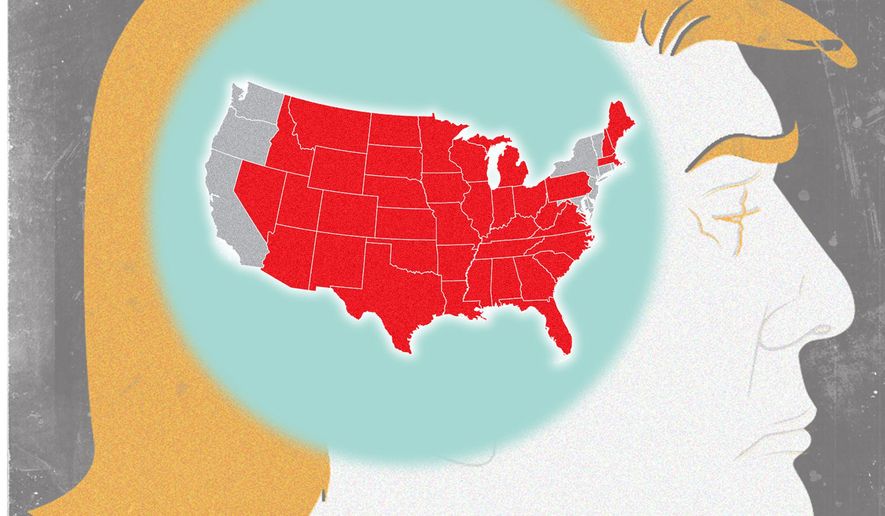OPINION:
Let’s not overdo Democrats’ attempted do-over: They still face a steep climb.
With 2024’s presidential race set for a reset, it’s worth looking at where it stood the weekend President Biden withdrew from it — barely three months before it ends. The appearance of what, on reexamination, may appear to be a close race obscures the potential electoral vote landslide lurking beneath.
First, the 2020 race was far closer than Democrats like to admit. They won by 4.3% of the popular vote, but that margin was driven by a roughly 7 million vote surplus in California and New York, which amounted to roughly 4.4% of the popular vote. Without it, Mr. Biden and then-President Donald Trump ran virtually even in the other 48 states.
Second, in the decisive electoral vote, Democrats’ win depended on less than 77,000 votes cast across Arizona, Georgia, Nevada and Wisconsin. Had Mr. Biden lost these, Mr. Trump would have won. The 2020 takeaway is twofold.
Assuming Democrats’ continued large California and New York vote surpluses are reflected in national polling, Democrats are running about 4.4 percentage points behind where they are registering. As of July 21, Real Clear Politics’ average of national polls showed Mr. Trump leading Mr. Biden by 3 points.
Looking at 2024’s Electoral College map, if Democrats held all the states they won in 2020, they would have a 303-235 lead. That means they could lose only 33 electoral votes and still win the presidency in November. Conversely, Mr. Trump needs to flip 35 electoral votes from the Democrats’ column to win.
Battleground states were everything in 2020; they still are in 2024. In 2020, Democrats won 11 states by roughly 10 points or less: Arizona, Georgia, Maine, Michigan, Minnesota, Nevada, New Hampshire, New Mexico, Pennsylvania, Virginia and Wisconsin; Mr. Trump won six states by roughly 10 points or less (Alaska, Florida, Iowa, North Carolina, Ohio and Texas). Democrats’ 11 battleground states amounted to 113 electoral votes; Mr. Trump’s six battleground states amounted to 112 electoral votes.
But Democrats’ 11 battleground states were far closer than Mr. Trump’s. Six of the Democrats’ 2020 battleground states (accounting for 77 electoral votes) had an average victory margin of 1.3 points; Mr. Trump’s average victory margin over his six battleground states was 6.1 points.
Looking at these close 2020 states in today’s polls, we see that Democrats’ slight positive margin in their six is gone: Their positive average of 1.3 points is now an average 4.1-point deficit. Arizona and Nevada are above a 5-point deficit for Democrats; with 17 combined electoral votes, these are over half the electoral votes Democrats can afford to lose. Essentially, all Democrats’ six closest 2020 battleground states are in jeopardy now.
Mr. Trump’s larger average 2020 positive margin in his six battleground states has increased, going from a 6.1-point average to a 7.5-point average today. At a 5.7-point advantage, North Carolina is the closest of Mr. Trump’s six 2020 battleground states. All of Mr. Trump’s 2020 battleground states are safe for him.
The 2024 electoral map shows that Democrats have no opportunity for pickups from Republicans’ 2020 column. That means they can’t fill any losses from their 2020 column. Conversely, Mr. Trump can pick up all six of the Democrats’ closest 2020 battleground states (accounting for 77 electoral votes). If his 5-point leads in Arizona and Nevada held, he would need only 18 more electoral votes from Pennsylvania (19), Georgia (16), Michigan (15) and Wisconsin (10). Pennsylvania alone would put him over, and he leads there by 4.5 points.
Making matters worse for Democrats, Mr. Trump has a chance at five other states (Maine, Minnesota, New Hampshire, New Mexico and Virginia) that Democrats won by roughly 10 points or less in 2020. If this sounds far-fetched, consider that the RCP average of polls shows Mr. Trump trailing by just 3 points in Minnesota and 3 points in New Hampshire, and leading by 0.4 points in Virginia. Presuming similar Democratic slippage in the other two states, then Mr. Trump could win 36 more electoral votes.
Finally, even Colorado is not that far a reach for Mr. Trump. RCP shows his deficit there at just 6.5 points — a 7-point improvement over this 2020 result. Combined, Mr. Trump could be targeting 12 Democratic states from 2020 with a total of 123 electoral votes — over three times the 35 he needs to win in November.
As in 2020, battleground states are everything in 2024. All of them are Democrats’ turf. Democrats are only playing defense (and losing). Mr. Trump is only playing offense (and winning). If all 123 electoral votes that Trump can realistically target swung to him, he would win 358-180, almost the same as Barack Obama’s margin over John McCain in 2008.
The real driver of the Democrats’ problems is the far-left policies of the Biden-Harris administration, not Mr. Biden himself. While Mr. Biden may have been pushed out, the Biden-Harris policies will push on, regardless of which candidate they put atop their ticket.
• J.T. Young was a professional staffer in the House and Senate from 1987 to 2000, served in the Department of Treasury and Office of Management and Budget from 2001 to 2004 and was director of government relations for a Fortune 20 company from 2004 to 2023.




Please read our comment policy before commenting.